- Home
- Deborah Harkness
The World of All Souls
The World of All Souls Read online
VIKING
An imprint of Penguin Random House LLC
375 Hudson Street
New York, New York 10014
penguin.com
Copyright © 2018 by Deborah Harkness
Penguin supports copyright. Copyright fuels creativity, encourages diverse voices, promotes free speech, and creates a vibrant culture. Thank you for buying an authorized edition of this book and for complying with copyright laws by not reproducing, scanning, or distributing any part of it in any form without permission. You are supporting writers and allowing Penguin to continue to publish books for every reader.
Illustrations by Colleen Madden
All photos courtesy of the authors except:
Here, here, here, here, here, here, here, here, and here: Anna Baldwin.
Here: Andreas Cariasco; here: Christian Hinkle, Shutterstock; here: Daemons Domain. Here: © The Fitzwilliam Museum, Cambridge; here: © Victoria and Albert Museum, London.
The following photos accessed via Creative Commons, with the following attributions: here and here by DAVID ILIFF; here by tejvanphotos; here by Daviessimo; here by Motacilla; here by Alistair McMillan; here by David Brossard; here by Photoglob Zurich; here by Indian Joe; here by Skouame; here by Pline; here by Fabien 1309; here by Berkay 0652; here by Calips; here by Spooky; here by Jose L. Filpo; here by Keith Patrick Martin; here by Sage Ross; here by Canon of Medicine, Ibn Sina; here by ΛΦΠ; here credited to Samuel and Mary R. Bancroft Memorial, 1935.
ISBN 9780735220744 (hardcover)
ISBN 9780735220751 (ebook)
Version_2
Dear Reader,
Welcome—or welcome back—into a world of daemons, humans, vampires, and witches, where a reluctant witch and a fifteen-hundred-year-old vampire discover the secrets left in a mysterious manuscript.
When I started writing the books in 2008, I had no idea that so many readers around the globe would take Diana, Matthew, and all the other Bishops and de Clermonts into their hearts and minds. Today I share the creatures in the All Souls trilogy with readers from Australia to Vietnam and Finland to Brazil. This book is for all of you.
My curious, engaged readers always have more questions than I can answer on social media, via email, or at a book signing. We’ve written this book with you in mind. We delved into my file cabinets and notebooks. We mined the stories for hidden nuggets of arcane lore and historical information. We’ve transformed some of what was in my imagination when I wrote the trilogy into something that could be shared.
As you explore the pages of this book, you will discover a treasure trove of information about the creatures and events of the trilogy. This companion volume gives you a chance to have a good rummage through my inspiration archive. Though some of your questions will be answered, we hope that they are replaced with new insights and connections. And as you follow the threads through history, legend, music, magic, and science, we hope that you feel a new sense of affinity for the characters and stories.
Enjoy your journey of discovery—or rediscovery—into the world of All Souls.
Best wishes,
Contents
Title Page
Copyright
A Note from Deborah Harkness
In Conversation with Deborah Harkness
Synopses
A Discovery of Witches Shadow of Night The Book of Life
Calendars Music of All Souls
Creatures
The Creatures of All Souls
Daemons Humans Vampires Witches
Characters
The A–Z of All Souls Characters
Organizations
The Congregation The Conventicle Knights of Lazarus Knights Templar Order of the Broome Order of St. Michael Order of the Defeated Dragon and the Drăculeşti
Oxford University Yale University
A Discovery of Witches Outtake
Locations
Oxford and Oxfordshire, England Scotland
Shadow of Night Outtake
France Spain Madison, New York, USA London, England Prague, Czechoslovakia Amsterdam, the Netherlands New Haven, Connecticut, USA New Orleans, Louisiana, USA Venice, Italy
Magic
Magic and Witchcraft: The World of Diana Bishop
The Goddess: Maiden, Mother, and Crone
Ghosts Elemental Magic The Craft Weaving Timewalking
Science
The Evolution of Matthew de Clermont
500–999 1000–1500 1500–1700 1700–1800 1800–1899 1900–1999
Alchemy
Opus Magnum and Symbols of Alchemy
The Arbor Dianae The Green Lion
The Chemical Wedding
The Philosopher’s Stone
Decorative Arts
Interior Spaces of All Souls
The Art, Fashion, and Jewelry of All Souls
Lifestyles
All Souls Recipes
Wine Tea Herbs and Medicinals
Gonçalves Manuscript 4890
All Souls Activities
Traveling in the All Souls World
Exercise in the All Souls World
Literature
The Literature of All Souls
Alchemy Mythology
History, Magic, Science and Religion
Plays and Prose Poetry and Verse
Translations
Translations for Words and Phrases in the All Souls Trilogy
Wider Reading and All Souls Resources
Acknowledgments
About the Author
It began with . . .
Portrait of the author hunting Easter eggs
In Conversation with Deborah Harkness
The Inspiration for All Souls
What drives your fascination with the past?
Ever since I was a small child, I loved history. My parents took us to historical sites when I was growing up outside of Philadelphia, and I loved dressing up in long skirts and imagining I lived in the eighteenth century. After my first trip to England to visit my mother’s family in the 1970s, I fell in love with fifteenth- and sixteenth-century history, pushing further back into the past.
I think those early experiences visiting historical places, and reading about them before and after, made history seem alive to me. I could imagine myself into colonial Williamsburg, or the Revolutionary War, or Warwick Castle, or Speke Hall. Once the past was a living, breathing place in my imagination, it never lost its fascination for me. The more I read, the more important it was that I know why people in the past did what they did. I’ve always been interested in what motivated people and how the particular conditions of their lives and experiences shaped those desires.
What triggered you to turn from your work as an academic historian to writing a fictional tale of a witch, a vampire, and a lost manuscript?
At the start of a family vacation in Puerto Vallarta, I walked through the airport and saw a big display of books about witches and vampires. I had just finished a book about the history of scientific inquiry in Elizabethan London and had been reading virtually nothing published after 1610 for years, so this move in to popular culture was something of a surprise to me. Looking at the jackets, I was struck with a couple of simple questions: If there really are witches and vampires, as these books suggested, what on earth do they do for a living? And why don’t I know any of them?
When I started writing the story, I really started by imagining a possible answer to those questions. I had spent six or eight weeks on it and had nine chapters completed before I ev
en told anyone else that I was working on something . . . strange. Though I hadn’t seriously considered writing fiction since tenth grade, it appeared that I was writing a novel.
Could you outline the initial journey of the All Souls trilogy coming into the hands of readers—how did you get from the spark of an idea to a published book and the spread of the trilogy worldwide?
It took me about nine months to complete the first full draft of the book. There was something very gestational about the process. And it was a big baby—more than 1,100 pages! It then took me three months (essentially my summer vacation from teaching) to carve 350 pages from it. I had a lot of help with that process from Lisa Halttunen (who is one of the collaborators on this book). After it was slightly more manageable in size, my agent, Sam Stoloff, put it out to potential publishers on a Thursday in September 2009. I got the news that Viking were interested after a class on Monday while sitting on a bicycle rack outside my lecture hall. By the following Tuesday, they had purchased the book.
That call came almost exactly a year after I started writing A Discovery of Witches. Many people told me that this kind of thing never happens. As far as I’m concerned, it’s proof that there has always been more than a bit of pixie dust and magic surrounding the All Souls trilogy.
It was surreal to have the book sell so quickly, and so soon after I’d started the writing process. After that, Viking took the book to the international book fair in Frankfurt, Germany, where it sold to other publishers around the world.
Happily, I was so busy working on the next book in the trilogy, Shadow of Night, and teaching my classes that I had time to let it all sink in slowly. Otherwise I think the sudden success might have been overwhelming—not to mention daunting!
The Writing of All Souls
As a professor of history and a person who juggles a wide range of interests, how do you balance writing with everything else in your life?
Sometimes balance just isn’t possible. Isn’t it a relief to say that? We all strive for it, and maybe it seems as if I’ve got some magic formula to achieve it, but actually I have good days and bad days just like everybody else.
As for my “formula,” it’s changed from book to book. When I was working on A Discovery of Witches, writing fiction was a very small part of my life. I wrote for the first few hours every day (from around 6:00 to 8:00 A.M.), and then I did my full-time job at the university. Once A Discovery of Witches sold to the publisher, I became an “author.” Then I had two jobs, and I also had to find time to keep writing. That’s when creativity was necessary. Shadow of Night, interestingly, was written almost entirely at night, from 10:00 P.M. to midnight, after the hullabaloo of the day had died down. I wrote The Book of Life whenever I could—life was very hectic by then. Now, as I move into writing other books—some of them even about the Bishops and de Clermonts!—I’m trying to get back to the kind of routine I had with A Discovery of Witches.
That’s easier said than done, however. Everybody reading this knows how hard it is to carve out quiet time for yourself and to give that time the same importance in your busy day as any other commitment. We always seem to shortchange ourselves in an effort to get everything else done. I try to get enough rest, enough exercise, and to eat properly—something we all need to do.
At this point I’ve learned that I really can’t write for more than a few hours a day. I’m better with shorter, more focused writing stints. I can write almost anywhere, including my office at home, at the dining-room table, in cafés, at my shared office space in town, on planes, in hotel rooms, and at libraries. Probably the weirdest spot I’ve ever written in was in my car at a highway rest stop on the I-5 in California. I was getting away for a writing week and I just had to pull over and put something on the page.
Because you’d been an academic writer for many years before you turned to fiction, what surprised (or delighted or frustrated) you most about writing a novel?
What surprised me most is that you are not in total control of your story—or at least I’m not. The characters seem to have a life of their own, and sometimes you just need to buckle your seat belt and go along for the ride. This was brought home to me in the very first book, when, with no plan or warning, Matthew got into the car, drove to Scotland, and Hamish opened the door. I had not anticipated that! But who could now imagine a world without Hamish?
I am sometimes frustrated by how hard it is to get what I see and feel so clearly onto the page so that someone else can experience it. This is where it’s vital to let other people whom you trust read your work. We are never our own best editors. A writer always needs fresh eyes and a fresh perspective.
You have said previously that you wrote the last lines of the trilogy at the same time you wrote the first. Was it difficult to stick to this ending? Did you find the story pulling you in different directions as you got deeper into writing it?
I did know how the trilogy would end (though I ended up editing the words a bit!), but I didn’t know exactly how we would get there. The story was well thought out through the beginning of what would become The Book of Life. However, what came between the beginning and the ending did change. In part that was because what I had sketched out was too ambitious and complicated—the perils of being not only a first-time trilogy writer but a first-time author as well. It also had to change because certain characters (namely Hamish and Gallowglass) weren’t part of my initial cast of creatures.
It was very important to me that I resolve to tie up the loose threads already present in the story so readers had a satisfying conclusion. Early in the writing of The Book of Life, it became clear that this wasn’t going to give me much room to introduce new characters or plot twists (two things I dearly love to do, it turns out). I now understand why so many “trilogies” have four, five, six—or more—books in them. Finishing the trilogy as a trilogy required determination and a very thick pair of blinders as I left behind characters and story lines that would take me too far from the central story of Diana, Matthew, and Ashmole 782.
How do the experiences of writing the three books compare? Which would you say was the easiest and which the most difficult?
When I began the trilogy, I thought I was writing a single book with three parts. Part 1 would be more of a love story, with the two main protagonists developing their relationship. Part 2 would be more a work of historical fiction. And Part 3 would be a work of science fiction with lots of thriller elements. No one was ever going to read it (or so I thought), and I thought it would be fun and interesting to play with different kinds of stories and writing.
Once I hit page 400 of Part 1, I realized this was going to need to be more than one book. Nevertheless, I held on to the idea that each book in the trilogy would have a slightly different feel and tackle different writerly problems. I still didn’t think anybody but I and my mother were ever going to read it!
Because of their distinct characters, the books felt very different as I was writing them. A Discovery of Witches was all joy and fun. I was writing furiously fast, and the words seemed to just jump onto the page. The major stumbling block I came across occurred when Matthew left Diana at Sept-Tours to return to Oxford. That was a dark time in the writing process, when I felt as if the characters had stalked off the page and gone on strike. They eventually came back, but it was scary. Shadow of Night was the most complicated to write (all those calendars . . .), but it is the work I’m most proud of because of the real history in it. The challenge in Shadow was making sure I hadn’t done something for the sake of the story that violated the history. I am a historian, after all! The Book of Life was without question the most difficult to write. That’s largely because the beginning was so tough. I had to draw two story lines together, and it took me eight attempts. I wrote eight different versions of the first four chapters before I got one that worked. It felt like trying to launch a jumbo jet with a rubber band.
How has the huge success o
f the trilogy and having so many readers changed the creative process for you?
When I wrote A Discovery of Witches and even the first half of Shadow of Night, the only person I had to please was myself. There were zero expectations and no deadline pressure. All of that changed, in a wonderful way, in 2011 with the success of the first book.
Since then I sometimes just have to step away from social media and book events so that I can focus on the stories and the characters and let everything else fade into background noise. It’s the only way for me to remain true to the world of All Souls and keep creating the original, fresh stories that people want to read.
The scope of the All Souls world is complicated, to put it mildly. How do you keep a handle on all the different threads. Do you have a massive database or a photographic memory—or both?
I do have a photographic memory, as it turns out. I also have a very sharp memory, one that’s been tuned by working for more than twenty years as a historian. In history you always have to balance out detailed information with the big picture. That skill has come in very handy for me as a novelist, especially a novelist who has built up an alternate world, with a slightly different set of natural laws, historical narratives, and cultural traditions.
I also have a database and two wonderful helpers (Lisa Halttunen and Jill Hough) who know how to look things up in it when I need to know what car someone drove or when Matthew was in Italy. Both Lisa and Jill have advanced degrees and excellent memories, too, and they help keep the story (and the writer) on course.
You’ve said that music is as essential to your writing as breathing, and you’ve shared many of the playlists you listened to when you wrote the trilogy. Can you describe how you construct your musical playlists? What comes first, the playlist or the writing?
They sort of construct themselves. Sometimes I’m driving in the car and hear a song on shuffle and it just strikes me: That’s a Matthew song or That’s a Diana song. Sometimes these insights are linked to a particular moment, but often it’s just a general character feeling.

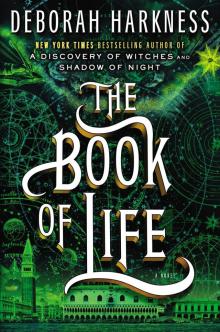 The Book of Life
The Book of Life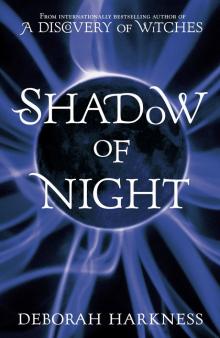 Shadow of Night
Shadow of Night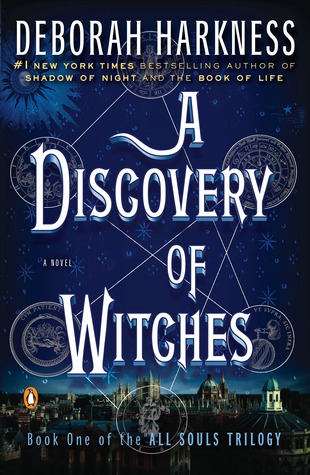 A Discovery of Witches
A Discovery of Witches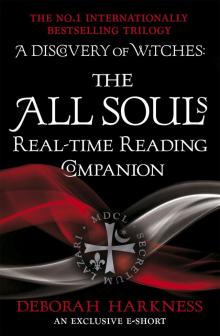 The All Souls Real-Time Reading Companion
The All Souls Real-Time Reading Companion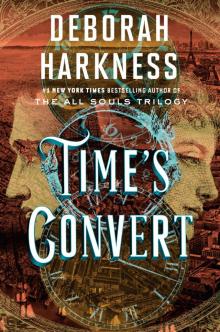 Time's Convert
Time's Convert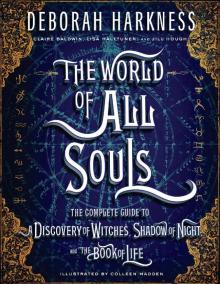 The World of All Souls
The World of All Souls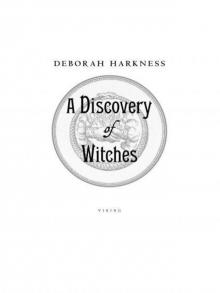 A Discovery of Witches: A Novel (All Souls Trilogy)
A Discovery of Witches: A Novel (All Souls Trilogy) Shadow of Night: A Novel
Shadow of Night: A Novel